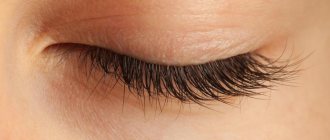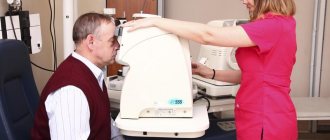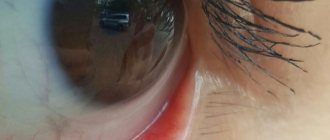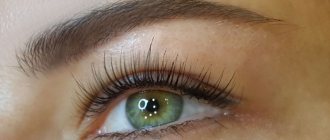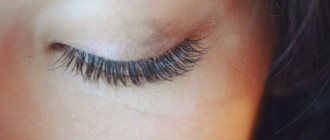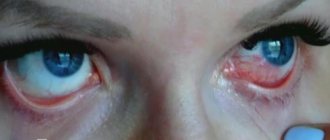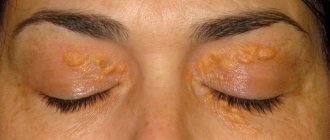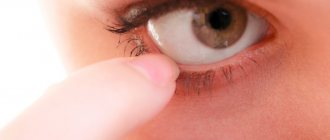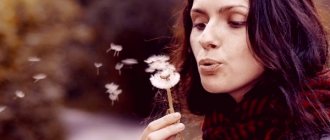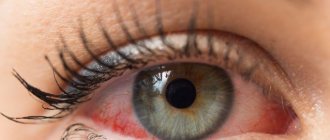general description
Entropion of the century (ICD 10, H02.0) is an inversion of the eyelid.
The edge of the eyelid is turned inward towards the eyeball. Volvulus can occur due to:
- spastic contraction m. orbicularis (spastic volvulus),
- cicatricial contraction of the conjunctiva and cartilage (cicatrical volvulus).
Spastic volvulus occurs almost always on the lower eyelid. For its formation, a minimal convulsive contraction of m is required. orbicularis and some prerequisites from both the eyelid itself and its relationship to the eyeball, for example, eyes deeply sunk into the orbit (in older people). In young people, spastic volvulus occurs with severe inflammation. Cicatricial volvulus develops as a result of cicatricial wrinkling of the conjunctiva and cartilage, usually a consequence of trachoma.
Diagnosis of trichiasis
Diagnosis of the disease begins with interviewing the patient and collecting anamnesis. It is necessary to clarify the genetic predisposition to the disease. Previous presence of burns, injuries and chronic inflammatory processes of the eyes.
Then a physical examination is performed:
- determination of visual acuity;
- external inspection;
- biomicroscopy of the direction of eyelash growth and the condition of the eyelid edges;
- identifying contact of eyelashes with the cornea and conjunctiva;
- determination of the condition of the cornea;
- biomicroscopy of the corneal conjunctiva using dyes.
A differential diagnosis of trichiasis with entropion and distichiasis is carried out. Madarosis is differentiated from marginal coloboma of the eyelid.
Clinical picture
Since the anterior edge of the eyelid edge with eyelashes growing on it turns towards the eye, the eyelashes begin to rub along the surface of the connective membrane and cornea, irritate them and lead to the formation of small epithelial defects and ulceration of the cornea, which in turn leads to the appearance of symptoms such as :
- Feeling of a foreign body in the eye.
- Redness of the eyeball.
- Itching and burning.
- Tearing.
- Decreased visual acuity.
- Ulceration of the cornea.
Drug and surgical treatment of trichiasis
Treatment of trichiasis should be aimed at reducing the impact on the cornea (to avoid pathologies) and cosmetic correction of the appearance of the eyelid. Correction is indicated for concomitant madarosis.
If trichiasis occurs as a result of infection, treatment with antibiotics or antiviral agents is needed, which will contribute to the death of harmful microorganisms.
If the defect is minor, the ophthalmologist can remove the eyelashes with tweezers. However, in most cases, the removed eyelashes grow back, causing corneal irritation again. Therefore, for trichiasis, it is necessary to resort to surgical intervention. The purpose of the operation is to radically correct abnormal eyelash growth.
Methods for treating trichiasis
- Epilation. The method is quite popular, but not the most effective. Hair removal is preferable if it is not possible to resort to surgical treatment immediately after diagnosis. The procedure must be repeated monthly, which leads to thinning and loss of pigment in the eyelashes. After a long course of hair removal, it is more difficult to solve the problem with other methods.
- Diathermocoagulation. The method is recommended for removing individual eyelashes that are not growing in the right direction. The removal procedure is carried out using a needle electrode, which the doctor uses along the eyelash growth line and deep into the skin, right down to the bulb. It is not recommended to do diathermocoagulation of all eyelashes in a row.
- Argon laser coagulation. The procedure is recommended for patients with individual eyelashes that grow incorrectly and injure the eye. This type of coagulation involves influencing the eyelashes from the point where an individual hair emerges in the direction of growth. After argon laser coagulation, therapy with antiseptic drops and ointments is needed.
- Through resection of the eyelid margin. The method is considered the most effective for trichiasis. Allows you to cover a wide area with abnormal eyelash growth. The procedure makes it possible to eliminate the defect, bring the edges closer together and perform layer-by-layer suturing of the area.
- Electrolysis. The results of this method are always long-term, although the procedure itself is lengthy. Eyelash hairs are removed using electrocautery. The hair follicle is treated with an electrode until the coagulated tissue becomes visible. It often takes several electrolysis sessions to completely get rid of the problem. This invasive procedure may cause scarring where the electrocautery is applied. The procedure is recommended for the treatment of local trichiasis.
- Cryotherapy. The method involves treating eyelashes with liquid nitrogen. Thus, they are removed: the hairs are frozen, then thawed at a temperature of 20°C. This makes it easy to remove eyelashes that grow incorrectly. Cryotherapy is recommended for generalized trichiasis, although it may result in excessive growth of connective tissue or skin death.
Trichiasis of the century - surgery
Some patients are also recommended to reconstruct the posterior wall of the eyelid using a mucosal flap from the lip. If there are no eyelashes (complete madarosis), the doctor may recommend a skin grafting procedure from the eyebrow area.
The operation to treat trichiasis involves removing the anterior layer of the movable eyelid at the site of the defect. It is recommended to resort to surgical intervention only if other methods have failed.
In case of distichiasis (additional row of eyelashes), resection of the affected area and suturing with a second row is possible. If eyelashes reappear with an incorrect growth trajectory, diathermocoagulation or argon laser therapy is indicated.
After eyelid surgery, you need to use antimicrobial drugs, as there is a high probability of secondary infection. Doctors also prescribe ointments that will inhibit inflammation.
Treatment of trichiasis should be comprehensive and complete. Physiotherapy allows you to consolidate the result: electrophoresis, ultra-high-frequency therapy. When treating trichiasis, it is recommended to reduce the load on the visual analyzer, follow all the rules of eye hygiene, including washing the lesion and irritated mucous membrane with saline solution.
Treatment of entropion of the eyelid
Spastic volvulus goes away on its own if the cause that caused it has disappeared. But if the irritation of the eye is long-term or the causative factor cannot be eliminated, then even a small enlargement increases and becomes persistent. Medical care is primarily aimed at eliminating the underlying cause. For mild volvulus, thin strips of adhesive tape are used, which are glued to the edge of the eyelid and the skin of the cheek. In more severe situations, surgical intervention is resorted to.
Cicatricial volvulus is treated exclusively by surgical methods.
Essential drugs
There are contraindications. Specialist consultation is required.
- Oftolik (a drug for moisturizing and protecting the cornea). Dosage regimen: 1-2 drops into the affected eye 5-7 times a day.
- Korneregel (stimulator of regenerative processes in the cornea, has an anti-inflammatory effect). Dosage regimen: instill 1 drop into the affected eye 3-5 times a day.
Trichiasis of the eyelid (ICD 10, H02.0) is abnormal growth of eyelashes. The eyelashes are not directed forward, as is normal, but to the sides or towards the eye.
Trichiasis develops as a result of cicatricial changes in the circumference of the hair follicles. Scars affect the correct position of the bulbs, giving them a tilt in one direction or another, which is why the eyelashes grow in the wrong direction. Scars develop due to chronic inflammation in the area of the eyelid margin. Trichiasis is often observed in the later stages of trachoma, prolonged blepharitis, injuries and burns of the eyelids.
What it is?
Trichiasis is an ophthalmic disease that causes abnormal eyelash growth. In the presence of such a problem, the growth zone of the hair follicles shifts, as a result of which the eyelash hairs are wrapped inward towards the eyeball. Many people experience eyelashes in the eye, but not everyone goes to the doctor, since in a mild form the clinical picture may not be present.
With normal eyelash growth, the eyelid protects the eyeball from dust, dirt, bright lighting and other aggressive factors. But if the ciliary edge turns inside the eye, then the hairs begin to scratch the cornea and conjunctiva, provoking the development of complications. The following types of pathological eyelash growth are distinguished:
- full – the entire row is growing incorrectly;
- partial – individual eyelashes curl towards the eye;
- unilateral – pathology is observed in one eye;
- bilateral - both organs of vision are affected.
Sometimes it is not the main, but an additional row of eyelashes that wraps around the eyeball. This pathological condition is called distichiasis. If two additional rows of eyelashes protrude, districhiasis is diagnosed. But such a phenomenon is extremely rare.
Treatment of trichiasis of the eyelid
If we are dealing only with individual incorrectly growing eyelashes, then we can limit ourselves to pulling them out with special tweezers, the branches of which are small areas well adjacent to each other. Of course, plucking has to be repeated when the eyelashes grow back. The bulbs of individual eyelashes can be completely destroyed by electrolysis. To do this, one of the electrodes is placed in the patient’s hand or placed on the shoulder. The other electrode ends with a thin needle, which is inserted into the hair follicle of the eyelash. Pass a current of 1-1.5 mA. After this, the eyelash is easily pulled out and does not grow back. If trichiasis is very common, then they resort to surgery.
If therapy is started in a timely manner, the prognosis is favorable.
Essential drugs
There are contraindications. Specialist consultation is required.
- Oftolik (a drug for moisturizing and protecting the cornea). Dosage regimen: 1-2 drops into the affected eye 5-7 times a day.
- Korneregel (stimulator of regenerative processes in the cornea, has an anti-inflammatory effect). Dosage regimen: instill 1 drop into the affected eye 3-5 times a day.
Treatment
There are various methods of treating trichiasis, and modern medicine is learning to cope with each disease in the least traumatic way, which will not cause complications and aesthetic disturbances.
You can consider some of them:
- Removing eyelashes with tweezers, so-called epilation. This method is considered not only the most common among patients, but also dangerous. Since the growth of a new hair occurs about 25-30 days, the procedure should be repeated with such frequency. The problem is that after this method, other methods no longer work.
- Cryotherapy is the use of very low temperatures using liquid nitrogen to remove hairs. The essence of the method is that the follicle is initially frozen, then thawed at a temperature of 19-20°C and falls out. Cryotherapy is often used for common forms of the disease. Complications – proliferation of connective tissue, death of epidermal cells.
- Electrolysis – hair removal using electrocautery. By applying the electrode to the hair follicle, the tissue is coagulated. This method is lengthy, painful, and requires a lot of effort and time. Used for limited types of trichiasis. A complication is the formation of scar tissue at the site of exposure.
- Laser coagulation is one of the simplest methods. To get results you only need to undergo a couple of procedures.
- Surgery is one of the backup methods. It is used in cases where other methods were ineffective or complications occurred. Sometimes even a skin graft is required.
Doctors say that the prognosis for trichiasis is favorable; the main thing is to find a good specialist and choose an individual treatment plan, and not to self-medicate.
Incidence (per 100,000 people)
| Men | Women | |||||||||||||
| Age, years | 0-1 | 1-3 | 3-14 | 14-25 | 25-40 | 40-60 | 60 + | 0-1 | 1-3 | 3-14 | 14-25 | 25-40 | 40-60 | 60 + |
| Number of sick people | 0 | 0 | 0 | 0 | 0 | 0 | 18 | 0 | 0 | 0 | 0 | 0 | 0 | 18 |
Definition of disease
Trichiasis of the eye is a pathology characterized by abnormal eyelash growth. In this case, they are directed not from the eyeball, but to the cornea. At the same time, the eyelid itself has its usual shape and does not curl up.
Not under all circumstances, abnormally growing hairs have the same shape, thickness, length and color. Most often, they have no shade at all and are very thin to the point of being impossible to detect without the help of magnifying optics and light.
The disease itself does not pose a serious threat to health, but it can cause other unpleasant pathologies.
A little about the prevention of trichiasis of the eyelid
To avoid such an unpleasant disease as trichiasis of the eyelid, inflammatory eye diseases (especially blepharitis) should be treated promptly. An inflammatory process that is not treated in time contributes to the degeneration of eyelash hair follicles and their abnormal growth. Burns (especially chemical burns) should be avoided and wounds and sores should be treated promptly. In the prevention of trichiasis, it is very important to carry out timely and adequate treatment of the primary disease. In addition, it is important to identify trichiasis as early as possible, preventing the formation of ulcerations on the cornea of the eye. This will get rid of the problem quickly. Another important aspect will be the choice of clinic for treatment. The professionalism of ophthalmologists is important here.
Symptoms
Visible signs of trichiasis of different types are not always visible to the naked eye. However, the patient may experience the following symptoms:
- Painful sensations;
- Feeling of a foreign body under the eyelid;
- Excessive lacrimation, lacrimation;
- Fear of light;
- Redness;
- Rapid fatigue of the visual apparatus;
- Itching, burning.
Constant pain, frequent blinking and tension can contribute to constant fatigue and headaches.
